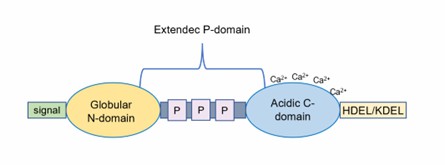Various food crops, vegetables, fruits, and ornamental plants in tropical, subtropical, and temperate regions are infected and damaged by plant nematodes. Calreticulin (CRT) is a highly conserved and functional protein family widely found in higher organisms. Belonging to the endoplasmic reticulum retention protein family, CRT can be isolated in vertebrates, invertebrates, and higher plants. It usually contains three major internal domains, consisting of a globular N domain and two Ca2+ binding domains.
Lifeasible, a leading global company, is committed to helping our customers achieve effective and successful research. We provide an analysis of calreticulin in plant nematodes, including synthesis, secretion, and various functions, achieving the purpose of controlling nematode diseases. We always deliver reliable results and reports on time to our customers worldwide.
 Fig.1 Structure of calreticulin.
Fig.1 Structure of calreticulin.
Lifeasible is always devoted to providing high-quality and satisfactory service to our customers. We provide our clients with direct access to our experts as well as promptly respond to their inquiries. If you are interested in our services or have any questions, please feel free to contact us or make an online inquiry.
Lifeasible has established a one-stop service platform for plants. In addition to obtaining customized solutions for plant genetic engineering, customers can also conduct follow-up analysis and research on plants through our analysis platform. The analytical services we provide include but are not limited to the following:
Get Latest Lifeasible News and Updates Directly to Your Inbox
Adaptive Evolutionary Mechanism of Plants
February 28, 2025
Unraveling Cotton Development: Insights from Multi-Omics Studies
February 27, 2025